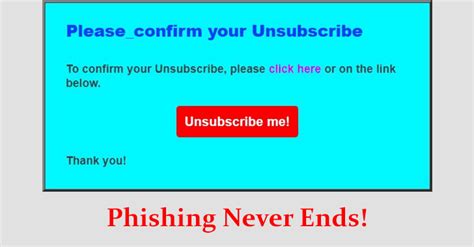
Unsubscribing from unwanted emails might seem like the obvious solution to inbox clutter, but cybersecurity experts warn that clicking that “unsubscribe” button could actually invite more spam, rather than less.
Many unsubscribe links found in spam emails are cleverly disguised traps designed to verify your email address is active and receptive, essentially painting a target on your inbox for future waves of unsolicited messages. Engaging with these links signals to spammers that your address is valid, making it a more valuable target for their campaigns.
According to cybersecurity professionals, the proliferation of sophisticated spam tactics necessitates a shift in how individuals manage unwanted emails. The traditional approach of hitting “unsubscribe” is increasingly risky, urging a more proactive and cautious strategy.
The seemingly simple act of clicking “unsubscribe” can trigger a series of unwanted consequences. Instead of removing you from a sender’s mailing list, it might confirm to spammers that your email address is legitimate, leading to an influx of even more spam.
“By clicking ‘unsubscribe,’ you’re basically saying, ‘Yes, I’m here, and I’m reading my emails,'” explains cybersecurity analyst Mark Thompson. “That confirmation is gold to spammers.”
This counterintuitive reality underscores the evolving sophistication of spam operations, where simple solutions can backfire, leaving users more vulnerable than before. Understanding these risks is crucial for protecting your inbox and personal information from malicious actors.
The potential dangers associated with unsubscribe links stem from several factors, including the lack of verification mechanisms, the prevalence of deceptive practices, and the economic incentives driving spam activities. Many legitimate businesses use unsubscribe links to comply with anti-spam laws and maintain a positive relationship with their customers, but distinguishing these links from malicious ones can be challenging.
“It’s often difficult to tell the difference between a legitimate unsubscribe link and a fraudulent one,” notes Emily Carter, a cybersecurity consultant. “Spammers are getting very good at mimicking the look and feel of legitimate emails.”
One common tactic is to create unsubscribe links that lead to websites designed to harvest personal information or install malware on your device. These websites may ask for additional details, such as your name, address, or phone number, under the guise of confirming your unsubscription request. In reality, this information can be used for identity theft, phishing attacks, or other malicious purposes.
Another risk is that clicking on an unsubscribe link can trigger the download of malicious software without your knowledge. This software may run in the background, collecting sensitive data, tracking your online activity, or even taking control of your computer.
To mitigate these risks, cybersecurity experts recommend adopting a more cautious and proactive approach to managing unwanted emails. Instead of clicking on unsubscribe links, consider using the spam filtering tools provided by your email provider or installing a dedicated anti-spam application. These tools can automatically identify and filter out spam emails, reducing the risk of accidental exposure to malicious links.
“The best defense against spam is a good offense,” advises Thompson. “Be proactive about protecting your email address and use the tools available to you to filter out unwanted messages.”
Another effective strategy is to avoid sharing your email address with untrusted sources. Be wary of online forms, surveys, and promotional offers that require you to provide your email address. Consider using a disposable email address for these types of interactions, which can help to protect your primary email address from spam.
“Think before you click,” says Carter. “Don’t give your email address to just anyone. The more you share it, the more likely you are to receive spam.”
In addition to these individual measures, email providers and technology companies also have a role to play in combating spam. They can improve their spam filtering algorithms, develop more sophisticated authentication mechanisms, and work together to identify and shut down spam operations.
“Fighting spam is a constant battle,” acknowledges Thompson. “It requires a collaborative effort from individuals, email providers, and technology companies.”
The rise of sophisticated spam tactics underscores the importance of cybersecurity awareness and education. Users need to be aware of the risks associated with clicking on unsubscribe links and other suspicious email elements. They also need to be equipped with the knowledge and tools necessary to protect themselves from spam and other online threats.
“Education is key,” emphasizes Carter. “The more people know about spam, the better equipped they are to avoid it.”
The problem of spam is not just an inconvenience; it also poses significant economic and security risks. Spam can be used to spread malware, launch phishing attacks, and conduct other types of cybercrime. It can also consume valuable resources, such as bandwidth and storage space, and reduce productivity.
According to a report by the Anti-Phishing Working Group, phishing attacks cost businesses billions of dollars each year. These attacks often start with spam emails that trick users into revealing sensitive information, such as passwords, credit card numbers, or bank account details.
“Spam is a gateway to cybercrime,” warns Thompson. “It’s a serious problem that needs to be addressed.”
The fight against spam is an ongoing challenge that requires a multi-faceted approach. By adopting a more cautious and proactive strategy, individuals can reduce their risk of exposure to spam and other online threats. Email providers and technology companies can also play a crucial role by improving their spam filtering algorithms and developing more sophisticated authentication mechanisms. Ultimately, the key to combating spam is to raise awareness and educate users about the risks involved.
In-Depth Analysis of Spam Tactics and Mitigation Strategies
The seemingly innocuous “unsubscribe” button, designed to liberate inboxes from unwanted clutter, has become a treacherous landscape fraught with potential pitfalls. Understanding the evolution of spam tactics and the counter-measures available is paramount in navigating the complexities of email security.
The Evolution of Spam Tactics:
Early spam was relatively unsophisticated, often characterized by poorly written messages and obvious scams. However, spammers have become increasingly adept at mimicking legitimate emails, using sophisticated techniques to bypass spam filters and trick users into engaging with their messages.
-
Image-Based Spam: To circumvent text-based spam filters, spammers began embedding text within images. These images often contain promotional messages or links to malicious websites.
-
HTML Manipulation: Spammers use complex HTML coding to disguise the true content of their emails. This can involve hiding text, using invisible characters, or redirecting links to unexpected destinations.
-
Personalization and Social Engineering: Spammers gather personal information from various sources to craft highly targeted emails. These emails may include the recipient’s name, address, or other details to increase their credibility. They often employ social engineering tactics, such as creating a sense of urgency or appealing to emotions, to trick users into clicking on links or providing sensitive information.
-
Typosquatting: Spammers register domain names that are similar to legitimate websites, but with slight misspellings. Users who accidentally type the wrong address may be redirected to a spam website.
-
Snowshoe Spamming: Instead of sending large volumes of spam from a single IP address, spammers distribute their messages across a wide range of IP addresses. This makes it more difficult for email providers to block their messages.
-
Compromised Accounts: Spammers gain access to legitimate email accounts through phishing attacks or password breaches. They then use these accounts to send spam, making it more likely that their messages will bypass spam filters.
Why Unsubscribe Links Are Risky:
The fundamental problem with unsubscribe links in spam emails is the inherent difficulty in distinguishing legitimate requests from malicious traps. Clicking on a fake unsubscribe link can have several negative consequences:
-
Address Verification: As previously mentioned, clicking confirms the validity of the email address, marking it as an active target for future spam campaigns.
-
Data Harvesting: The unsubscribe page may request personal information under the guise of confirming the unsubscription, which can then be used for identity theft or other malicious purposes.
-
Malware Installation: Clicking on the link may trigger the download of malware onto the user’s device. This malware can steal sensitive data, track online activity, or even take control of the computer.
-
Fake Unsubscription: The unsubscribe page may claim that the user has been removed from the mailing list, but in reality, they continue to receive spam.
Proactive Mitigation Strategies:
Given the risks associated with unsubscribe links, a more proactive and cautious approach is necessary. This involves a combination of technical measures and user education.
-
Robust Spam Filters: Email providers need to continuously improve their spam filtering algorithms to identify and block spam emails more effectively. This includes using machine learning techniques to analyze email content, sender reputation, and other factors.
-
Blacklists and Whitelists: Blacklists contain lists of known spam senders and IP addresses. Whitelists contain lists of trusted senders and IP addresses. Using both blacklists and whitelists can help to filter out spam while ensuring that legitimate emails are delivered.
-
Authentication Protocols: Email authentication protocols, such as Sender Policy Framework (SPF), DomainKeys Identified Mail (DKIM), and Domain-based Message Authentication, Reporting & Conformance (DMARC), help to verify the authenticity of email messages. These protocols can prevent spammers from forging sender addresses.
-
Reporting Spam: Users should report spam emails to their email provider or to organizations like the Federal Trade Commission (FTC). This helps to identify and track spammers.
-
Email Aliases: Create aliases for different purposes. For example, use one alias for online shopping and another for newsletters. If one alias starts receiving spam, you can simply disable it without affecting your primary email address.
-
Privacy Settings: Review the privacy settings on social media and other online platforms. Limit the amount of personal information that is publicly available.
-
Password Security: Use strong, unique passwords for all online accounts. Enable two-factor authentication whenever possible.
-
Software Updates: Keep your operating system, web browser, and other software up to date. Software updates often include security patches that fix vulnerabilities that spammers can exploit.
-
Be Skeptical: Be wary of unsolicited emails, especially those that ask for personal information or contain suspicious links. Always verify the sender’s identity before clicking on any links or providing any information.
-
Use a Virtual Private Network (VPN): When using public Wi-Fi networks, use a VPN to encrypt your internet traffic. This can help to protect your data from being intercepted by hackers.
The Role of Anti-Spam Legislation:
Anti-spam laws, such as the CAN-SPAM Act in the United States, aim to regulate commercial email and protect consumers from unwanted messages. These laws typically require senders to obtain consent before sending email, provide a clear and conspicuous way for recipients to unsubscribe, and include a valid physical address in their messages.
However, anti-spam laws are not always effective in combating spam. Spammers often operate from outside of the jurisdiction of these laws, making it difficult to enforce them. Furthermore, spammers are constantly developing new techniques to circumvent these laws.
The Importance of User Education:
Ultimately, the most effective way to combat spam is to educate users about the risks involved and provide them with the tools and knowledge they need to protect themselves. This includes teaching users how to identify spam emails, how to avoid clicking on suspicious links, and how to report spam.
Cybersecurity awareness training should be a regular part of every organization’s employee training program. This training should cover topics such as spam, phishing, malware, and social engineering.
By working together, individuals, email providers, technology companies, and governments can make progress in the fight against spam.
The Future of Spam:
The problem of spam is likely to persist for the foreseeable future. Spammers are constantly evolving their tactics, and new technologies, such as artificial intelligence (AI), are making it easier for them to create convincing spam emails.
However, there are also new technologies being developed to combat spam. AI is being used to develop more sophisticated spam filters, and blockchain technology is being used to create more secure email authentication systems.
The fight against spam is an ongoing arms race. As spammers develop new tactics, security professionals must develop new countermeasures. The key to winning this battle is to stay one step ahead of the spammers.
Frequently Asked Questions (FAQ) about Email Spam
Q1: What makes clicking the “unsubscribe” button in a spam email potentially dangerous?
A: Clicking the “unsubscribe” button in a spam email can backfire because it often serves as a confirmation to spammers that your email address is active and monitored. This validation makes your inbox a more valuable target, potentially leading to an increase in spam rather than a decrease. Some unsubscribe links may also direct you to phishing websites designed to steal personal information or install malware.
Q2: How can I identify a legitimate unsubscribe link from a potentially harmful one?
A: It’s challenging to definitively distinguish between legitimate and harmful unsubscribe links. However, some indicators include: the sender’s email address (does it match the company it claims to be?), the overall quality and professionalism of the email (grammar, spelling, design), and whether you recall subscribing to the email list in the first place. If the email looks suspicious, it’s best to avoid clicking any links. Legitimate companies usually send a confirmation email to which you have to reply to confirm your unsubscription.
Q3: What are some alternative methods to unsubscribe from unwanted emails without clicking the “unsubscribe” button?
A: Instead of clicking the unsubscribe button, you can:
- Mark the email as spam: This helps your email provider learn to filter similar emails in the future.
- Use email filtering tools: Configure filters to automatically move emails from specific senders or with certain keywords to the spam folder.
- Contact the company directly: If you recognize the sender, visit their official website and look for contact information to request removal from their mailing list.
- Use a third-party unroll service: Services like Unroll.me can help you manage subscriptions from a centralized dashboard (but be mindful of their privacy policies).
Q4: What steps can I take to reduce the amount of spam I receive in the first place?
A: To proactively minimize spam:
- Be selective about sharing your email address: Avoid providing it on untrustworthy websites or in public forums.
- Use a strong, unique password for your email account: This prevents hackers from accessing your account and sending spam from it.
- Enable two-factor authentication: This adds an extra layer of security to your email account.
- Use a disposable email address for online registrations: Services like Mailinator or Guerrilla Mail provide temporary email addresses for one-time use.
- Review privacy settings on social media: Limit the visibility of your email address and other personal information.
Q5: What role do email providers play in combating spam, and what can I do to help?
A: Email providers are responsible for implementing spam filters and other security measures to protect their users. You can help by:
- Reporting spam emails: This helps the provider improve its filtering algorithms.
- Marking legitimate emails as “not spam”: This helps the provider learn to distinguish between legitimate and spam emails.
- Using the provider’s security features: Enable features like two-factor authentication and phishing protection.
- Keeping your email client up to date: Updates often include security patches that address spam vulnerabilities. By working together, individuals and email providers can help to create a safer and more spam-free online environment.









